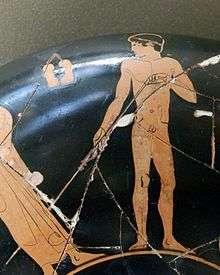Amentum

An amentum (Greek ankule) was a leather strap attached to a javelin used in ancient Greek athletics, hunting, and warfare, which helped to increase the range and the stability of the javelin in flight. Stability in flight was important because it allowed the javelin to land on its point, which was the only way the throw could be accurately recorded in competition or be useful against a live target. The amentum also increased the effective length of the throwing arm as does a spear-thrower and so enhanced speed. In the experiments made by General Reffye for the Emperor Napoleon, a javelin that could be thrown only 20 metres by hand could be thrown 80 metres with the amentum. The advantage of the amentum are the high precision for fast flying light javelins of less demanding construction than atlatl darts. A construction similar to the atlatl in energy transfer mechanics is the plumbata.
The javelin was held at ear level and released after a short run. The amentum was looped over the first two fingers of the throwing hand so as to slip off when the throw was made. In competition throwing for distance, including the Ancient Olympic pentathlon at Olympia, Greece, a blunt javelin would be launched at about 45 degrees, but in war or the chase, a sharp weapon was thrown much closer to the horizontal. Javelins and their amenta were used both on foot and from horseback.
The amentum was attached firmly, at or near the centre of gravity of the shaft. By putting the amentum behind the centre of gravity it is possible to increase the distance thrown, but at the sacrifice of accuracy. Hence the amentum was detachable, and the athlete fastened it to suit his taste shortly before use. The winding of the amentum added rotation and therefore accuracy to the projectile, similar to the effect of rifling on a bullet.[1] The experiments conducted by H. A. Harris support the theories based on vase paintings of the proper use of an amentum.[2]
Similar throwing straps were used on light javelins throughout Europe. Italian, Gaulish, and Spanish troops used them before and after the Roman conquests, they are mentioned in ancient Irish story, and remains have been found on spears in the Nydam bog finds, where some appear to have been permanently fastened with studs. A similar device was used in New Caledonia, but in the rest of the world the spear-thrower was the usual device for increasing the speed and range of light javelins.[1]
References
- 1 2 Gardiner, E. Norman (1907). "Throwing the Javelin". The Journal of Hellenic Studies. 27: 249–273. doi:10.2307/624444.
- ↑ Harris, H.A. (1963) "Greek Javelin Throwing", in Greece & Rome, Second Series, Vol. 10, No. 1 (Mar., 1963), pp. 26-36. Cambridge University Press on behalf of The Classical Association. Retrieved 21 September 2013.